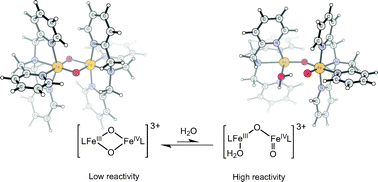Observed enhancement of the reactivity of a biomimetic diiron complex by the addition of water - mechanistic insights from theoretical modeling†
Abstract
The biomimetic

* Corresponding authors
a Department of Physics, Stockholm University, Stockholm, Sweden
b Department of Chemistry and Center for Metals in Biocatalysis, University of Minnesota, Minneapolis, Minnesota, USA
The biomimetic

 Please wait while we load your content...
Something went wrong. Try again?
Please wait while we load your content...
Something went wrong. Try again?
A. J. Johansson, H. Noack, P. E. M. Siegbahn, G. Xue and L. Que Jr., Dalton Trans., 2009, 6741 DOI: 10.1039/B907263B
To request permission to reproduce material from this article, please go to the Copyright Clearance Center request page.
If you are an author contributing to an RSC publication, you do not need to request permission provided correct acknowledgement is given.
If you are the author of this article, you do not need to request permission to reproduce figures and diagrams provided correct acknowledgement is given. If you want to reproduce the whole article in a third-party publication (excluding your thesis/dissertation for which permission is not required) please go to the Copyright Clearance Center request page.
Read more about how to correctly acknowledge RSC content.
 Fetching data from CrossRef.
Fetching data from CrossRef.
This may take some time to load.
Loading related content
